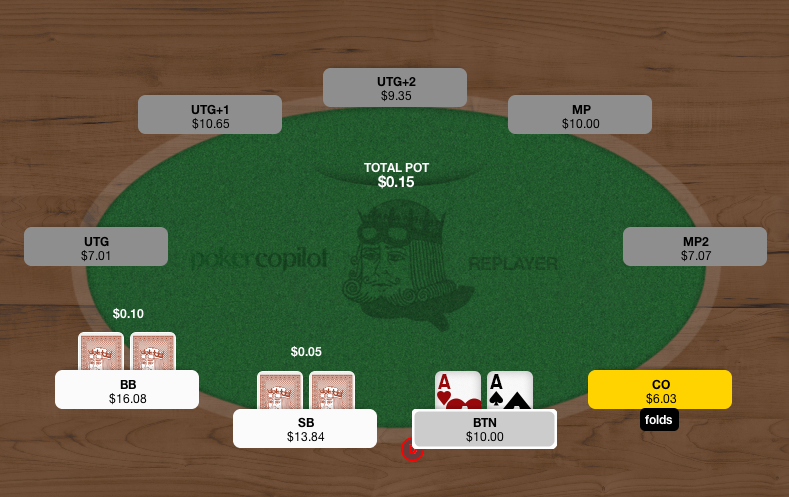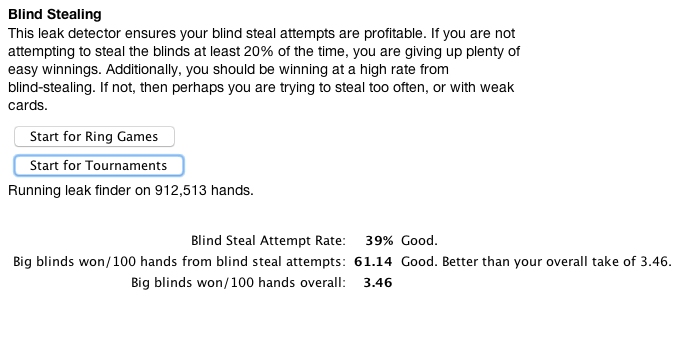Blind stealing in online poker
Stealing the blinds is an extremely profitable technique for online poker. If you haven’t mastered blind stealing, you are leaving plenty of easy money on the table.
I’ll explain blind stealing here, and offer you some strategies I’ve developed by investigating an database of 2 million poker hands from a range of player types.
Blind Steal defined:
You have a blind steal opportunity if:
- You are on the button; and
- Everybody so far has folded, leaving just you, the big blind, and the small blind in the hand.

Some people consider that if you are in the cut-off (one position to the right of the dealer button), you also have a blind steal opportunity, but in this article, we’ll stick with the stricter definition.
The small blind can also try to steal the big blind, but in this guide, we’ll just deal with the button’s blind steal opportunities, as this is the most common scenario.
When to steal
So you are on the button, and all the players before you have folded. You now have three options:
- fold. This leaves the blinds to battle it out between them.
- call. This gives the big blind a free ride to the flop. No matter what hand he has, he’ll see the flop, where even 7–2 could become a powerful hand. Furthermore, the small blind only has to call half a big blind more, to see the flop. As the pot already has 2.5 big blinds in it, this is an easy decision for the small blind. So your call has most likely let one player see the flop for free, and another player see the flop cheaply. And you have almost no information about what hands they may have.
- raise. If you now raise, you’ve made a blind steal attempt. The big blind will fold most hands to a raise.
Generally, you should almost always fold or raise in this situation.
I’ve done some calculations over a very large database of hands, and discovered that:
- In tournaments, 53% of the time, the big blind folds to a steal attempt.
- In ring games, 62% of the time, the big blind folds to a steal attempt.
Think that through: more than half the time, a blind steal attempt will give you the blinds without any further play. This suggests that you should make blind steal attempts with a large range of hands.
But it gets even better, as I explain in the section below on playing the flop. Keep reading.
What size should my blind steal attempt be?
A typical opening pre-flop raise should be 2.5 to 3 big blinds. More than this would be an “overbet”, that is a bet far too big in comparison to the pot, and your potential gain.
What if the big blind calls pre flop?
Here’s where the beauty of the blind-steal attempt comes in. On the flop, you have the best position and you were the pre-flop aggressor. So you have a big advantage. The villain needs to act first, but is in a bad situation. Typically the villain will check on the flop.
Why? Most times when the big blind calls your blind-stealing raise, he doesn’t have a strong hand. I know this because he folds to a blind steal attempt only about 60% of the time. 40% of the time he called, which implies the player calls with an extremely wide range of possible hands. So more often than not, you should make a continuation bet on the flop. That is, bet again. How much? Between 50% and 100% of the pot. Less than that makes it cheap for the villain to call. More than that and you are risking too much for the size of the pot.
Let’s look at what my big database of tournament hands tells us about making a continuation bet after a blind steal attempt:
53% of the time when the big blind defended against a blind steal attempt AND faced a continuation bet, they folded.
In ring games, the big blind who tried to defend folded to 44% of continuation bets.
Let me put pre-flop and flop percentages together: in tournaments, the big blind folds to 53% of blind steal attempts. When he defends, he folds a further 53% of time when facing continuation bets. In the second case you’ve won the blinds and the big blind’s attempt to defend against the steal. Less than 25% of the time, you’ll need to play against a villain who is brave enough to make it past your continuation bet.
A blind steal attempt followed by a continuation bet is an extremely rewarding technique in the long run.
What if the big blind villain reraises preflop?
You now have tough decisions to make. Here I can only give vague tips. You’ll need to appraise what you know about your opponent, and take into account the strength of your own hand. I’d tend towards folding non-premium hands, and calling with premium hands. Unless I had observed that this particular villain liked to reraise blind steal attempts. In short, you have the type of decision-making situation that makes poker so enjoyable and difficult.
Blind steal caution #1: Don’t be foolhardy
If you try to steal the blinds with terrible cards, you could end up at showdown. You’ll reveal to the table that you tried stealing without the cards to back it. Do this a couple of times and the table will stop respecting your blind steal attempts. Even if that is the case though, not all is bad. You’re still at a pure mathematical advantage. Such is the beauty of the blind steal attempt.
Blind steal caution 2: Play the player
Remember the old poker mantra: “play the player, not the cards”.
Some players will enjoy reraising your blind steal attempts, putting you in a complicated situation. Be more cautious with blind steal attempts when sitting to their right. Losing a big portion of your stack in a blind-steal attempt gone wrong is not fun.
Other players will fold almost anything to a raise. So if they call, give their hand respect on the flop. Chances are, you’ll have the worse hand on the flop. But you can also increase your stealing range against these players.
Blind stealing and Poker Copilot
Poker Copilot’s poker HUD offers statistics on:
- how often a player makes a blind steal attempt (BSA)
- how often a player folds the big blind to a steal attempt (FBB) Use these two stats well, and you’ll be able to adjust your blind stealing strategy against each player.
Poker Copilot has a Blind Stealing leak detector. Use it to find out your blind steal rate, and your take from big blind stealing. Poker players are often surprised when the leak detector shows them how profitable blind stealing is.

Summary
- Blind-stealing is profitable. You should be doing it, and doing it well.
- You should attempt to steal roughly half of all your blind steal opportunities.
- Be prepared to often continue the blind steal attempt onto the flop, when the villain defends.
When you are on the button and everyone so far has folded, consider the blinds to be your personal property, and play strongly to grab them as often as you dare.